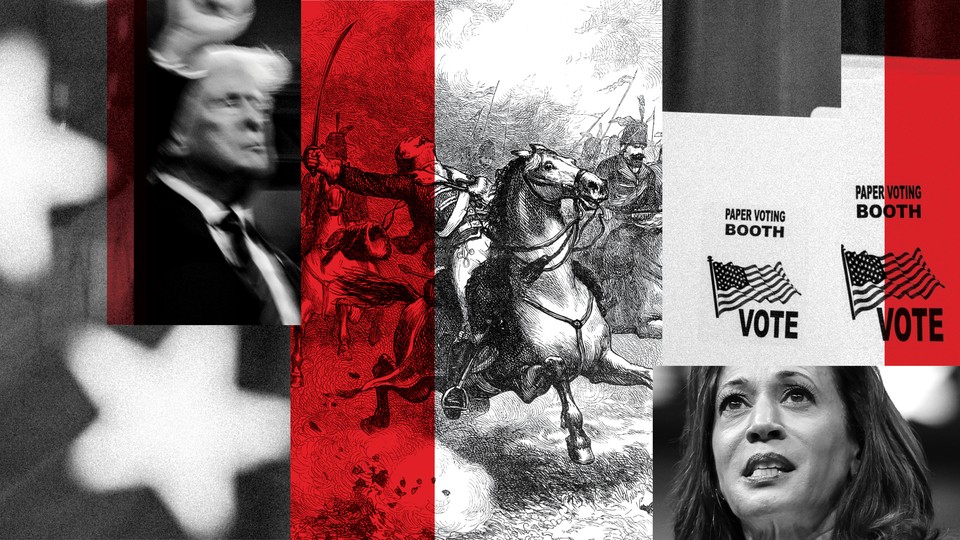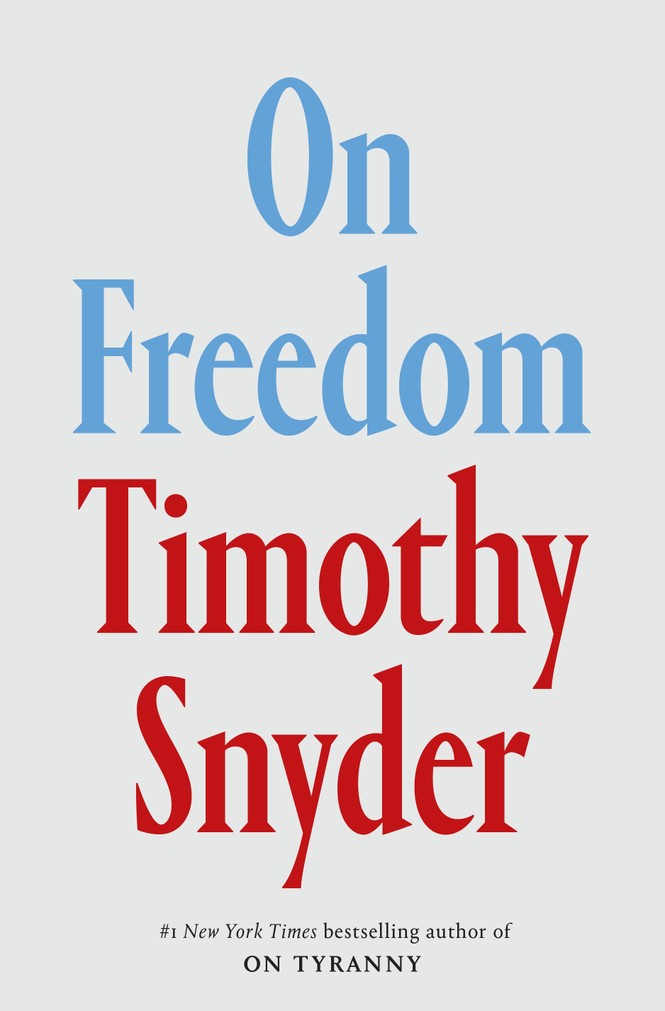Poland’s Gift to the American Republic
8 min read
What does it feel like to watch a republic die? And what does it take to revive one? Whether the American republic survives could be decided in the next few months. Decades or centuries hence, the signs will seem clear; today, we live through one of those moments when we feel the weight of our own decisions, even as the larger historical forces, powerful as they might be, remain elusive in our daily life.
This is what I was thinking, walking along Delaware Avenue to attend the Democratic National Convention in Chicago last month, when I found blocking my path a snowplow named “Casimir Plowaski.” The machine, brought into summer service to assist the city’s crowd-control effort, was christened Plowaski earlier this year by Chicagoans in a popular vote. To name Department of Streets and Sanitation equipment after an 18th-century hero of America’s Revolutionary War is a whimsy of democracy, but it may also be a reminder of how human choices at crucial moments make a democracy possible.
Without that snowplow’s more accurately spelled namesake, Kazimierz Pułaski, there might well have been no Democratic National Convention, no Chicago, no United States of America even: The Revolutionary War was a close-run thing—and would almost certainly have been lost without the aid of revolutionaries from abroad. Pułaski, an experienced Polish military officer, organized the American cavalry, and very possibly prevented the capture or death of George Washington at the Battle of Brandywine. (Pułaski himself was later killed in action, at the Battle of Savannah in 1779.)

This article has been adapted from Timothy Snyder’s new book, On Freedom.
Chicago in fact has an intersection of Pulaski and Washington Streets. Without the encounter of those two men in life, their fight against tyranny would likely have failed. As politicians make freedom central to their election campaigns this fall, it is tempting to think nostalgically about the Revolution of 1776 and the War for Independence, to glorify the Founding Fathers. But we are not at a revolutionary moment; instead, the choice is between decay and reform. Today’s contest is still—thanks to the democracy that Pułaski and his comrades in arms bequeathed us—one fought with ballots, not bullets, but the stakes are no less consequential.
The republic will either be revived or perish. And the events in Poland that brought Pułaski and other republican compatriots to America should be a cautionary tale for the modern nation he helped create.
Pułaski, like other Poles in the 1770s, hoped for the American republic to live because he was watching the Polish republic perish. Pułaski was a veteran of wars with Russia. Catherine the Great, a German princess, had usurped the Russian imperial throne after the murder of her husband in a coup d’état in 1762. Catherine’s plans for imperial expansion included the destruction of the old Polish-Lithuanian Commonwealth, also sometimes known as the First Polish Republic. A former lover of hers had been elected king of Poland, and her ambassador in Warsaw was arresting her political enemies. Pułaski joined a group of Polish patriots who chose to meet the Russian threat on the battlefield.
The Polish rebels won some battles in 1768, but soon fell back on desperate tactics, including kidnapping the king. That plot fizzled, leaving the monarch abandoned in the countryside asking for directions back to the capital. Implicated in the conspiracy, however, Pułaski had to flee to France. There, he was discovered by Benjamin Franklin and decided to fight for the United States.
Pułaski’s decision to go into exile was fortunate. After the rebels were defeated, in 1772, the three neighboring regimes partitioned Poland, each taking territory. Russia was ruthless: Poles who had fought for their country were branded and sent to Siberian exile.
The Polish republic was finished by foreign intervention, but its long, slow decline had domestic roots. It had been not a democracy by modern standards, but a government of the nobility. Given that about 10 percent of the male population was noble, Poland proudly had at the time the world’s broadest franchise of any large state. The nation did have a titular monarch, but the position was a weak one, and the king was chosen by election.
Though much lauded then and since, not least for its duration of more than two centuries, the republic’s system had a basic flaw: tremendous inequality in status and wealth. The greater part of the population was enserfed, bound to the land. Most of the serfs, though, were owned by a few wealthy families (known as magnates) that controlled the economy and dominated the Parliament. A majority of the nobles, who theoretically could have owned serfs, in fact did not; in practice, these nobles were clients of the magnates—a situation not unlike the plantation society of the American South in the 18th century.
The equality of nobles was a pleasant fiction. The design of the Polish legislature was also a problem. Based on an antiquated principle of unanimity known, misleadingly, as the “golden freedom,” the parliamentary system allowed a single nobleman to veto any proposal—a service easily bought by either a magnate or an agent of Russia who wanted to block an undesirable reform.
Institutionalizing injustice not only is a violation of others’ liberty, but also creates habits of mind among the privileged that undermine the very idea of freedom. The power of Poland’s “golden rule” against the will of the majority lives on in American ideas of negative freedom, particularly in the notion that government should be kept too small and weak to hinder oppression or rectify injustice.
But Polish solidarity with the American revolution also bore an idea of positive freedom. In the 1770s and ’80s, after Pułaski’s exile, a debate about serfdom took place in Poland, and a few noblemen emancipated their serfs. Again, as limited as that effort was, a great cause emerged from the dying republic to survive in a newborn one.
Pułaski was not a reform-minded politician but a military leader; we cannot know how he would have addressed such problems had he survived and returned to Poland, which in any case ceased to exist after Catherine’s final intervention in 1795. As it was, Pułaski simply fought on until death in America for what he understood as the cause of liberty.
The snowplow named for him suggests a hulking masculine presence. The Pułaski of history was not that. His comrades recalled a darting, elfin figure, self-willed to the point of insubordination. They also noted that he appeared uninterested in women. That could mean many things, but forensic archaeological study of Pułaski’s skeletal remains now suggests that our revolutionary hero may in fact have been a heroine: a biological woman, or possibly an intersex person.
The Chicago snowplow is perhaps more evocative of another Polish revolutionary friend of America: Tadeusz Kościuszko. Even more than the cavalry officer, this military engineer was indispensable to the Continental Army. Vitally for a young army that was, especially at first, often in retreat, Kościuszko created escape routes that the British forces would find rough going and designed barriers to obstruct their pursuit. He was also in charge of fortifications, such as the ones at West Point, where he later persuaded Thomas Jefferson and others to establish an officers’ academy.
A military academy is a symbol of meritocracy, and even today American military academies are engines of social mobility. Kościuszko was in a special position to observe merit: During his service in the Continental Army, he was assigned as his aide-de-camp Agrippa Hull, a free Black volunteer from Massachusetts. The two men spent more than four years of military campaigning together. In combat in the South, they witnessed how slavery impeded the American cause, because people enslaved by colonists saw the British as their natural allies—something that George III’s forces exploited by issuing proclamations that promised freedom.
Can a republic be founded by people who own other people? As the defenders both of Polish serfdom and of American slavery pointed out, the Greeks and the Romans owned slaves. The classical democracies and republics, however, ultimately proved failures. The American Founding Fathers were attentive to some of the structural problems of the classical model: Thomas Jefferson declared that all men deserved equal rights, Alexander Hamilton worried that a president might be beholden to foreign tyrants, and James Madison argued for a representative system rather than management by elite.
Kościuszko would go a step further than the Founders in the cause of freedom. He returned to Poland, and led first the Polish army against the Russians and later an unsuccessful popular uprising. After Poland’s final defeat, Kościuszko had to live the rest of his life in European exile. At the time of his return from the United States, he had never been paid for his service in the Continental Army, but the fledgling republic did eventually settle its debt to Kościuszko. He then made an agreement with his friend Jefferson: Jefferson would have power of attorney in the United States to send Kościuszko the interest on his earnings—and then, upon Kościuszko’s death, to use his capital to buy the freedom of enslaved people in America, including those on Jefferson’s own plantation.
Kościuszko did die before Jefferson, in 1817, but he left behind other documents that confused the legacy. For whatever reason, Jefferson never implemented the plan, and when Jefferson himself died, he left debts—some of which were paid off by the sale of his slaves.
The turmoil generated by the flaws of the two republics spread onward through the 19th century. The naturalization of slavery in the U.S. Constitution certainly hindered not only the revolutionary generation, but also its heirs. The next great American rebellion was centrally in defense of slavery. At the same time, in 1863, when Polish nobles rebelled against Russian rule, some did so to preserve serfdom (which by then had been abolished in the Russian empire).
Aside from the inherent moral horror of human bondage, the social habits of rationalized inequality made political institutions weaker and righteous causes less persuasive. This inherent problem prevented any Polish rebellion in the 19th century from achieving a truly united, national character. The peasants could imagine that a Russian victory might help them, just as many enslaved Americans in the 1770s or the 1810s had hoped for a British victory over the United States.
The flaws of the Polish system were obvious to early republican Americans, who applauded when a new Polish constitution in 1794 removed them. But then Russia invaded again, precisely because the prospect of Polish democracy posed a threat to Russian autocracy. This, of course, is the fundamental reason Russian President Vladimir Putin seeks today to destroy Ukraine—because a democratic Ukraine would threaten his story that only autocracy is possible.
Today, the flaws of the American system are all too apparent, its constitutional pressure points amplified by partisan misinterpretations based in ill will and supported by oligarchs and foreign foes. As the story of our Polish allies reminds us, the problems of injustice were inscribed from the beginning: the republic’s unfulfilled promise of freedom.
This article has been adapted from Timothy Snyder’s new book, On Freedom.

When you buy a book using a link on this page, we receive a commission. Thank you for supportingThe Atlantic.



